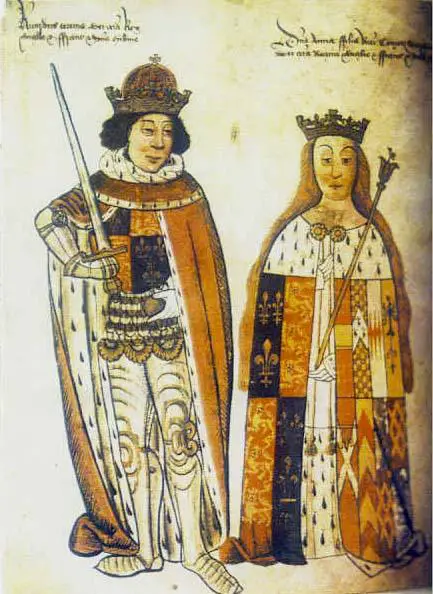Mary I could be a tough cookie at times. She was courageous and strong-willed, and she showed that side of her personality on 15th March 1551 when she rode through the streets of London with a large company of knights, gentlemen and ladies doing something that was illegal and an act of defiance against her half-brother, King Edward VI.
Find out more in today's video:
Also on this day in history:
- 1493 – Arrival of Christopher Columbus, explorer and navigator, at Palos in Spain after his 1492 voyage to the New World.
- 1504 – Death of John Arundell, Bishop of Exeter, at Exeter House in the Strand, London. He was buried at St Clement Danes Church in London.
- 1532 – William Warham, Archbishop of Canterbury, criticised Henry VIII in the House of Lords when Parliament was discussing the annulment. The King responded with what historian G. W. Bernard describes as “foul language”.
- 1554 – Marian martyr John Hooper was deprived of the bishopric of Gloucester while imprisoned in Fleet Prison. He had been charged with owing over five hundred pounds in unpaid first fruits, a charge he denied.
- 1628 – Burial of composer John Bull in the Groenplats cemetery near Antwerp Cathedral.



I just LOVE this time period of Mary, after Henry but before her own queen ship. I think it’s a very interesting section of time and we can see pretty clearly how she’s thinking. She had to sign away her faith, her integrity, her soul, for her father, and here she wasn’t giving in for anything in the world. Michelle t
Go Mary! Carrying her rosary, in royal robes, her ladies and gentlemen riding out in force, probably to Mass as well, through Smithfield to Cheapside which was still a bit posh then before it was sold to the City of London, under Elizabeth I, probably people waved and cheered as King Henry’s true daughter rode by, you go girl! Mary had been forced to compromise her faith and birth right and sign it all away, but now she was openly courageous because we are commanded to put the law of God before the law of man, so Mary would see her brother as making the law of men. Edward saw his Protestant faith as the true way and to Protestants and Evangelicals he was a new Josiah, putting the law of Yahweh first. The majority of his subjects remained Catholic, regardless of the new reforms. Mary had written that she and her household would continue to hear Mass in her own household but Edward had rebuked her about it as he was the King. Mary wasn’t prepared to compromise any more and here we see an act of bravery and defiance as well as Faith.
Her response to Edward can be summed up in one word to his not liking it.
“Tough!”
What you said about Mary being the daughter of two Royal Houses is important. It underlines the way Mary was viewed by many of her supporters and how she regarded her own Royal dignity. Mary was the true born heir of Henry Viii and his true wife Katherine of Aragon, daughter of the Catholic Majesties and of full royal blood, but Edward was a half blood Prince and although legitimate, his mother had not been crowned. Elizabeth was considered illegitimate by Mary, her father may be Henry Viii but her mother was considered not to be his true wife and Anne had been executed for adultery and treason. Both were half blood royal children, Mary full blood royal and she may as well have had a banner saying as much so confident and so dignified was she in her own lawful status. It was something Elizabeth I learned from Mary I, to always show off her Royal status with a good show of magnificent bling. We see this in the portraits and we see both Elizabeth and Mary did this with their clothes.
I was watching the repeat on BBC four last night of the 500 years celebration of Hampton Court Palace with Lucy Worsley and David Starkey in which they faithfully recreated the Baptism of Prince Edward on 15th October 1537 with a live procession. Princess Mary wore this wonderful dress of cloth of silver, which, although she could have chosen gold, she chose because it was rarer and more expensive and made her stand out. We think of Elizabeth as being elaborate in her dress but in fact it was Mary at this period who was the more magnificently dressed. Elizabeth has been noted for more sombre dress. (At the Baptism of course she was only four so I am taking about during her brother and sister’s reigns.). We have a magnificent roll made showing the procession and Elizabeth was drawn as an adult because it was made a couple of decades later, but it is correct in every other detail. Mary must have looked spectacular riding through the city and I can imagine it was some statement.
I love the diary of Henry Manhew (sorry can’t quite remember how to spell his name) because he gives us very detailed eye witness accounts of these memorable events. It’s like being there. I think you can read it on Archive.com. for free or download part of it. He gave a wonderful description of Mary’s coronation which made me feel as if I was there. I particularly love it because he was an ordinary merchant, not L and P, or the Spanish Ambassador but a citizen, albeit a leading one of the City of London, not writing for the state, but for us, the audience, for the future, an independent account. Sorry to waffle but these original sources get me excited.
Oh, no, you aren’t waffling or anything of the sort. I love your replies. You’re very knowledgeable and generous in your sharing. I will check out that website, I’d love to read it. Michelle t
Hi Michelle, that is very kind of you. The correct name of the man who wrote the diary is Henry Machyn, knew it was something like that. Thanks again.